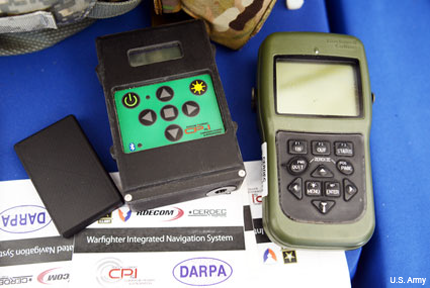Device can track soldier movements without GPS
Army researchers are developing a navigation system called WINS that can locate a soldier on a map when GPS signals are unavailable.

WINS, at center, uses inertial sensors to determine location.
Army researchers are developing a pocket-size device that will give soldiers precise geolocation information even when GPS signals are unavailable.
The Warfighter Integrated Navigation System (WINS), being developed at the Communications Electronics Research Development and Engineering Center, uses a variety of sensors to track a soldier’s movement from a last known location, recording footsteps, speed, time, altitude and other factors to show the soldier’s location on a map.
"It's got a number of inertial sensors, such as a pedometer and an accelerometer, things you will find on your cell phone but of a higher quality," Osie David, a CERDEC researcher, said in a news release. "Even if the enemy is denying you GPS or the terrain is, you can still get known location on here so it will show up on your Nett Warrior device or your command and control system."
Finding alternatives to GPS is a focus for the Defense Department precisely for those times when Global Positioning Systems signals don’t get through, whether because of terrain such as dense forests or jungles, or enemy interference. GPS signals can be jammed even with low-powered devices or spoofed by stronger signals.
Or both. In 2011, Iranian engineers jammed the GPS signal for an U.S. RQ-170 Sentinel drone, then spoofed its coordinates to make it land in Iran instead of its base in Afghanistan. University of Texas students also have demonstrated using spoofing to take control of unmanned aircraft and even an 80-foot yacht.
The military doesn’t expect that it ever will do without GPS—it’s still the most accurate and far-reaching geolocation system ever created and likely will remain so for the foreseeable future. But in addition to hardening GPS signals against jamming and other electronic warfare attacks, researchers are working on alternatives for those times when GPS service is blocked.
The Defense Advanced Research Projects Agency, for example, has been developing chip-scale inertial measurement units that use chip-scale atomic clocks for navigation. U.K. researchers are working on a sensor system that scans the environment and cross-references that information with a database of the terrain and structures in an area. Maritime officials also are considering an updated, digital version of the Loran (Long Range Navigation) system used to guide ships in World War two but was eventually made obsolete by GPS.
Like the DARPA and U.K. projects, WINS would rely on an initial GPS signal for a starting point, as well as for a corrective signal if it’s used for too long, because its accuracy will decrease over time. It will, however, display its error range so the user knows when he or she is looking at a rough estimate. "It's still better than having no GPS at all," David said.
Even if its accuracy is short-term, WINS could provide a vital link when necessary, such as in a jungle, David said. "I'm navigating around and I lose the GPS because with the triple-canopy jungle, the GPS can't penetrate that,” he said. “I don't know where I am on the map, so I'm in a bad situation. If I want to know exactly where I am so I can call for reinforcements or resupply, WINS is going to give me my location on a map, no matter where I am."
Although still in development, David said he expects WINS or a subsequent device built on WINS technology, will someday be fielded.




